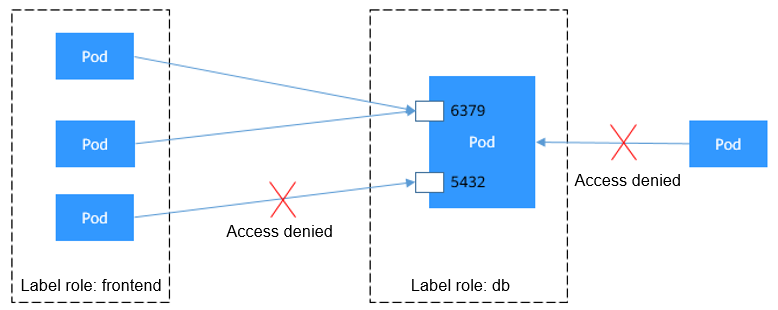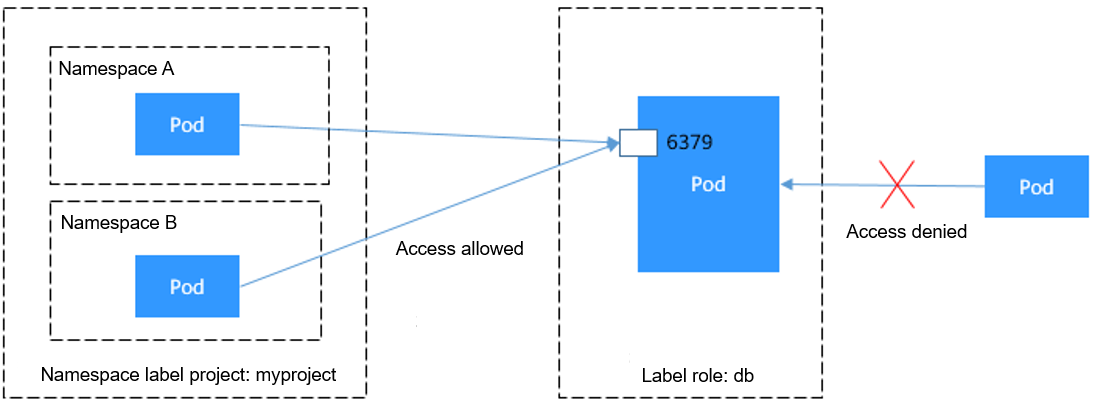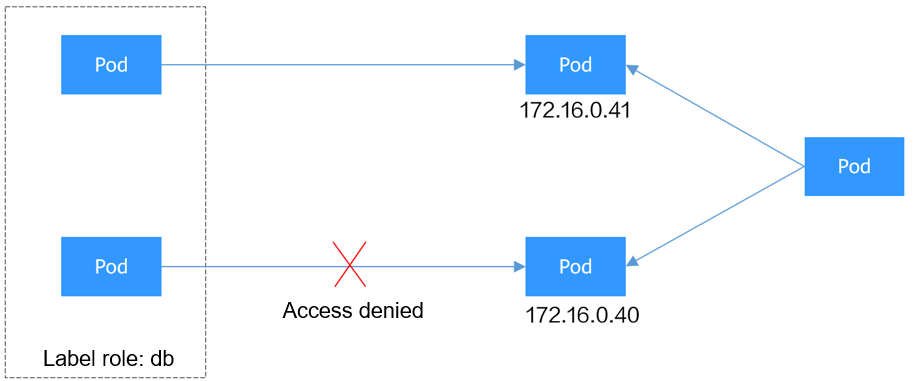Network Policies¶
Network policies are designed by Kubernetes to restrict pod access. It is equivalent to a firewall at the application layer to enhance network security. The capabilities supported by network policies depend on the capabilities of the network add-ons of the cluster.
By default, if a namespace does not have any policy, pods in the namespace accept traffic from any source and send traffic to any destination.
Network policies are classified into the following types:
namespaceSelector: selects particular namespaces for which all pods should be allowed as ingress sources or egress destinations.
podSelector: selects particular pods in the same namespace as the network policy which should be allowed as ingress sources or egress destinations.
ipBlock: selects particular IP blocks to allow as ingress sources or egress destinations. (Only egress rules support IP blocks.)
Constraints¶
Only clusters that use the tunnel network model support network policies. Network policies are classified into the following types:
Ingress: All versions support this type.
Egress: Only the following OSs and cluster versions support egress rules.
OS
Cluster Version
Verified Kernel Version
EulerOS 2.5
v1.23 or later
3.10.0-862.14.1.5.h591.eulerosv2r7.x86_64
3.10.0-862.14.1.5.h687.eulerosv2r7.x86_64
EulerOS 2.9
v1.23 or later
4.18.0-147.5.1.6.h541.eulerosv2r9.x86_64
4.18.0-147.5.1.6.h766.eulerosv2r9.x86_64
4.18.0-147.5.1.6.h998.eulerosv2r9.x86_64
Network isolation is not supported for IPv6 addresses.
If upgrade to a cluster version that supports egress rules is performed in in-place mode, you cannot use egress rules because the node OS is not upgraded. In this case, reset the node.
Using Ingress Rules¶
Using podSelector to specify the access scope
apiVersion: networking.k8s.io/v1 kind: NetworkPolicy metadata: name: test-network-policy namespace: default spec: podSelector: # The rule takes effect for pods with the role=db label. matchLabels: role: db ingress: # This is an ingress rule. - from: - podSelector: # Only traffic from the pods with the "role=frontend" label is allowed. matchLabels: role: frontend ports: # Only TCP can be used to access port 6379. - protocol: TCP port: 6379
The following figure shows how podSelector works.

Figure 1 podSelector¶
Using namespaceSelector to specify the access scope
apiVersion: networking.k8s.io/v1 kind: NetworkPolicy metadata: name: test-network-policy spec: podSelector: # The rule takes effect for pods with the role=db label. matchLabels: role: db ingress: # This is an ingress rule. - from: - namespaceSelector: # Only traffic from the pods in the namespace with the "project=myproject" label is allowed. matchLabels: project: myproject ports: # Only TCP can be used to access port 6379. - protocol: TCP port: 6379
The following figure shows how namespaceSelector works.

Figure 2 namespaceSelector¶
Using Egress Rules¶
Egress supports not only podSelector and namespaceSelector, but also ipBlock.
Note
Only clusters of version 1.23 or later support Egress rules. Only nodes running EulerOS 2.5 or EulerOS 2.9 are supported.
apiVersion: networking.k8s.io/v1
kind: NetworkPolicy
metadata:
name: deny-client-a-via-except-cidr-egress-rule
namespace: default
spec:
policyTypes: # Must be specified for an egress rule.
- Egress
podSelector: # The rule takes effect for pods with the role=db label.
matchLabels:
role: db
egress: # Egress rule
- to:
- ipBlock:
cidr: 172.16.0.16/16 # Allow access to this CIDR block.
except:
- 172.16.0.40/32 # This CIDR block cannot be accessed. This value must fall within the range specified by cidr.
The following figure shows how ipBlock works.

Figure 3 ipBlock¶
You can define ingress and egress in the same rule.
apiVersion: networking.k8s.io/v1
kind: NetworkPolicy
metadata:
name: test-network-policy
namespace: default
spec:
policyTypes:
- Ingress
- Egress
podSelector: # The rule takes effect for pods with the role=db label.
matchLabels:
role: db
ingress: # This is an ingress rule.
- from:
- podSelector: # Only traffic from the pods with the "role=frontend" label is allowed.
matchLabels:
role: frontend
ports: # Only TCP can be used to access port 6379.
- protocol: TCP
port: 6379
egress: # Egress rule
- to:
- podSelector: # Only pods with the role=web label can be accessed.
matchLabels:
role: web
The following figure shows how to use ingress and egress together.

Figure 4 Using both ingress and egress¶
Creating a Network Policy on the Console¶
Log in to the CCE console and click the cluster name to access the cluster console.
Choose Policies in the navigation pane, click the Network Policies tab, and click Create Network Policy in the upper right corner.
Policy Name: Specify a network policy name.
Namespace: Select a namespace in which the network policy is applied.
Selector: Enter a label, select the pod to be associated, and click Add. You can also click Reference Workload Label to reference the label of an existing workload.
Inbound Rule: Click
 to add an inbound rule. For details about parameter settings, see Table 1.
to add an inbound rule. For details about parameter settings, see Table 1.
Table 1 Adding an inbound rule¶ Parameter
Description
Protocol & Port
Select the protocol type and port. Currently, TCP and UDP are supported.
Source Namespace
Select a namespace whose objects can be accessed. If this parameter is not specified, the object belongs to the same namespace as the current policy.
Source Pod Label
Allow accesses from the pods with this label. If this parameter is not specified, all pods in the namespace can access the port.
Outbound Rule: Click
 to add an outbound rule. For details about parameter settings, see Table 1.
to add an outbound rule. For details about parameter settings, see Table 1.
Table 2 Adding an outbound rule¶ Parameter
Description
Protocol & Port
Select the protocol type and port. Currently, TCP and UDP are supported. If this parameter is not specified, the protocol type is not limited.
Destination CIDR Block
Allows requests to be routed to a specified CIDR block (and not to the exception CIDR blocks). Separate the destination and exception CIDR blocks by vertical bars (|), and separate multiple exception CIDR blocks by commas (,). For example, 172.17.0.0/16|172.17.1.0/24,172.17.2.0/24 indicates that 172.17.0.0/16 is accessible, but not for 172.17.1.0/24 or 172.17.2.0/24.
Destination Namespace
Select a namespace whose objects can be accessed. If this parameter is not specified, the object belongs to the same namespace as the current policy.
Destination Pod Label
Allow accessing the pods with this label. If this parameter is not specified, all pods in the namespace can be accessed.
Click OK.